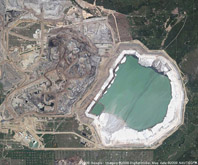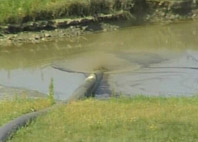Alberta orders cleanup of oil sands waste
 Edmonton, Alberta — Almost a year after 500 ducks died in toxic oil sands sludge, Alberta’s energy regulator is directing companies to finally deal with dozens of lake-sized tailings ponds. The ponds collect waste left behind when multibillion-dollar plants process tar-like bitumen and have grown so large in four decades that they can be seen from space.
Edmonton, Alberta — Almost a year after 500 ducks died in toxic oil sands sludge, Alberta’s energy regulator is directing companies to finally deal with dozens of lake-sized tailings ponds. The ponds collect waste left behind when multibillion-dollar plants process tar-like bitumen and have grown so large in four decades that they can be seen from space.
Alberta’s oil sands giants have until Sept. 30 to file plans with the Energy Resources Conservation Board that are to include a timeline for eventually closing the tailings ponds. The companies will be required to process all tailings water and dispose of sludge starting in five years and stretching over several decades.
The directive also calls on oil sands producers to curb liquid tailings by finding other disposal methods, such as pumping them into abandoned bitumen mines. Enforcement options will include denial of future expansion plans or even closing parts or all of any plants that ignore the directive.
Fingers are being pointed after hundreds of ducks were found dead or dying in a toxic tailings pond belonging to oilsands giant Syncrude Canada Ltd.
CTV Edmonton’s Joel Gotlib told Newsnet on Wednesday that it’s the worst such incident in the history of northern Alberta’s oilsands.
Environmentalists are furious, governments are demanding answers and Syncrude – located about 40 kilometres north of Fort McMurray – is scrambling to contain the damage, he said.
The tailings ponds are formed during the oilsands extraction process, Miles Kitagawa of the Alberta Toxics Watch Society told CTV.ca on Wednesday.
“Syncrude utilizes something called the Clark hot water process, where they crush bitumen-containing oil, mix it with heated water and use that to separate the bitumen out of the ore,” he said.
The leftover water is dumped in the tailings ponds, which contain a mixture of clay, sand water and hydrocarbons, he said.
Drinking a glass of water from a tailings pond would be like drinking a diluted glass of oil or gasoline, Kitagawa said.
The ponds are supposed to have measures in place that keep migrating waterfowl from landing on the ponds, such as scarecrows and noisemakers.
In a news release issued Tuesday, Syncrude’s president and CEO Tom Katinas said noisemakers had been deployed at all the company’s other tailings ponds.
“However, due to the extreme winter weather conditions in the region last week, the deployment of these devices on the Aurora Settling Basin was delayed,” he said.
“After the rapid weekend thaw, we were in the process of deploying the audible noisemakers on Monday, April 28th when this incident occurred. Eighteen propane-fired noisemakers are now operating at this site.”
This is the first time such a large flock of birds has been affected in Syncrude’s 30-year history, he said, adding the company estimates that 400 to 500 birds are affected.
Efforts to rescue the surviving birds are being hampered by ice around the pond’s edges. There are also reports the ducks are diving to avoid humans who try to come near.
In statement released on Tuesday, Alberta Environment said: “Under the Environmental Protection and Enhancement Act (EPEA), Alberta requires that Syncrude have a waterfowl protection plan in place that includes a comprehensive bird deterrent program for all tailings ponds.
“If Syncrude did not comply, the Alberta government will take action, with penalties up to $1 million.”
Environment Canada has said it will work in conjunction with the provincial department.
Migratory birds are a federal responsibility, and Alberta Environment noted that hundreds of thousands of waterfowl pass through northeastern Alberta each spring and fall.
Alberta’s Premier Ed Stelmach said he was concerned the company didn’t report Monday’s incident, noting the government found out about the incident from a tipster.
“If something has happened of this sort, then we feel that the company is obligated to report to the minister of the environment,” he said. “It’s a condition of the licence.”
Oilsands under attack
Greenpeace Canada said Tuesday in a news release that this incident, is “yet another example of the deadly implications of Alberta’s rampant tarsands development.
“The fact that this devastating incident wasn’t reported by Syncrude begs the question of how many other incidents have been quietly covered up to safeguard their image,” said spokesman Mike Hudema.

Environmentalists have been pushing for a moratorium on oilsands development for a number of reasons, such as:
- The social impacts of rapid development
- Harm to the northern boreal forest
- The contribution of emissions caused by oilsands production to global warming and climate change
The waterfowl crisis comes as Ron Stevens, Alberta’s deputy premier, is lobbying U.S. lawmakers to exclude the oilsands from a “dirty” oil law.
Stelmach decisively won re-election earlier this year and campaigned on a policy of letting the market decide the pace of oilsands development.
He has also committed his province to greenhouse gas reductions targets that many have criticized as inadequate and weak.
A week ago, protesters dropped from the ceiling at the annual premier’s dinner.
“Stelmach, the best premier oil money can buy,” read a large banner with a prominent Greenpeace logo. “Stop the tarsands!”
Stelmach told his audience that he would be travelling to Europe and southern California this year to sell the message that oilsands development is proceeding in a responsible way.
We cannot sit back and let others damage our reputation and give the world a false picture of Alberta,” Stelmach said.
The Alberta Liberal party said the incident’s timing is ironic, coming as Stelmach gets ready to launch a $25-million public relations campaign to improve the oilsands’ image.
You can return to the main Market News page, or press the Back button on your browser.

